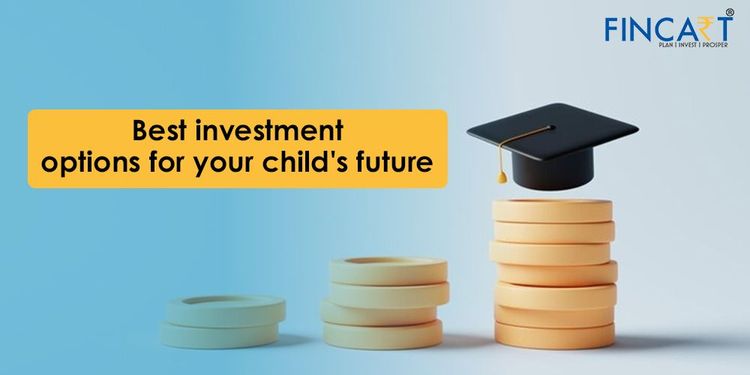Table of Contents
ToggleParenting is a constant effort to improve your child’s future in all ways possible. Their education is of primary concern. You want to provide your child with the best education possible, despite the steep rise in education costs. It is inflation that is to be blamed for this, but a child education plan is the best way to combat it.
Investing for a longer period yields the best results since compounding works in your favor. The investment opportunities available to your child are numerous. Here are some of them:
Best Child Investment Plans to Invest in 2024
Securing a child’s future can be challenging, and many parents strive to build a solid financial foundation for their children. However, it’s common for people to realize their funds are insufficient when the need arises. To establish a robust financial backup, making wise investment choices at the appropriate times is crucial. With numerous investment plans available, it’s essential to select options based on specific needs and suitability. Tailoring the investment approach to align with the child’s future goals ensures a more effective and secure financial strategy.
Sukanya Samridhi Yojana (SSY)
This scheme is initiated by the government for girl children below the age of 10 years old. This allows you to open two accounts for two daughters. It is quite easy to open an account for this, you can go to a bank or a post office.
To open a Sukanya Samridhi Yojana account, you must deposit 250 rupees. A maximum of Rs. 1.5 lakh can be deposited each year. For the first 15 years after opening an SSY account, you must continue to deposit. For instance, if your daughter is six years old, the scheme will mature when she is 27. A partial withdrawal is permitted after 18 years of age, and that too for marriage-related reasons.
Mutual Funds
A mutual fund is considered to be an excellent investment strategy for leaving you with a high corpus. A long-term financial investment such as this diversified equity can be ruled by mutual funds. Risk comes with equity investment, but so do high returns. To minimize risk, diversify your investments. Investment planning for a long period is primarily a way to gain the reward of compounding interest.
A mutual fund can be invested in two ways: through a SIP or by lump sum. The most popular investment method is SIP (Systematic Investment Plan). SIPs are disciplined investments that deduct a set amount each month from your account for investment, helping you reach your goal. If you’re considering entering the world of mutual funds, it’s essential to create a comprehensive mutual fund investment planner. This planner can assist you in setting financial goals, determining risk tolerance, and outlining a systematic approach to achieving your investment objectives.
Unit Linked Insurance Plans (ULIPs)
ULIPs are the best choice for ensuring financial security and creating wealth. A ULIP or Unit Linked Insurance Plan offers both investment and insurance services. As with any normal insurance policy, ULIPs also require regular premiums, the only difference being that they are linked to the market. Your child’s education & marriage costs can be covered swiftly with ULIPs!
In addition, if the policyholder dies, the child will receive a lump sum or regular payments, according to the policy. Tax-free returns are available after maturity. The government, however, has limited the investment of such a strategy to less than 250,000 premiums per year. It is important to note that ULIPs require a minimum commitment of 5 years. This makes them a good investment for long-term goals.
Public Provident Funds (PPF)
A popular government-funded scheme introduced by the Ministry of Finance in 1968, Public Provident Funds have been around for quite some time. In terms of long-term investment horizon, PPF received a lot of attention from investors. To get the best returns on your investment, it is recommended that you stay invested for at least 15 years, offering valuable financial advice for planning your financial goals. You may also consider opening a PPF account under your child’s name for their needs.
PPF accounts allow you to create a tax-free fund for your child for 15 years. A partial withdrawal can be made after the 6th or 7th year if your child needs financial assistance. As soon as your child becomes an adult, they can contribute to and extend the PPF account. PPFs currently have an interest rate of 7.1% per annum, compounded annually. PPF account holders receive interest every 31st of March. You can claim up to 1.50 lakh under Section 80C every year as a tax benefit with PPF.
Gold ETF
The addition of this investment can also be made towards your child’s education goal. The non-depreciating value of gold makes it a valuable asset. Each gold ETF unit represents one gram of gold, which makes them mutual fund units. Alternatively, Gold ETFs are also known as paper gold. Due to their digital availability, gold ETFs are safer and do not require additional storage and security costs. Through the stock exchange, gold ETFs can be bought and sold easily.
Also Read: Gold vs. Silver: Which is Better as an Investment?
Importance of Child Investment Plans in India
Putting money aside for your children can make a big difference in their lives. It’s super important because prices keep going up, and if you plan well, you can beat that and have enough for your children. Having some savings can also help if something unexpected and expensive happens. Basically, by saving money for your children now, you’re helping them in lots of important times in their lives. It can make their education better, help them be independent, and even start their own thing. The money you save acts like a safety net, making sure they start their grown-up lives in the best way possible.
Benefits of Investing in Child Plan in 2024
There are many benefits of investing in child plans.
Dual Advantage: Child investment plans offer a combination of savings and life insurance, ensuring financial security for your child’s future.
Emergency Funds: These plans allow partial withdrawals in case of financial emergencies, providing flexibility and immediate access to funds.
Financial Security: In the event of an unfortunate incident, the plan provides a lump sum payment, securing your child’s financial well-being. The plan remains active, with the insurance company covering future premium payments.
Tax Benefits: Child investment plans offer tax deductions on premiums paid (up to ₹1.5 lakh) under Section 80C. The payout at the end of the policy term is also tax-exempt under Section 10(10D) of the Income Tax Act, 1961.
Best Child Investment Plans 2024
Some of the best investment plans to secure your child’s future can be:
Sl. No | Plan Name | Description |
1 | Sukanya Samriddhi Yojana | Government-backed savings scheme for the girl child. |
2 | Public Provident Fund (PPF) | Long-term investment with a 15-year maturity period. |
3 | Equity-Linked Saving Schemes | Tax-saving mutual funds with a 3-year lock-in period. |
4 | Systematic Investment Plan (SIP) | Regular investment in mutual funds, reducing market impact. |
5 | Unit-Linked Insurance Plans | Insurance combined with investment in equity and debt. |
6 | Fixed Deposits for Children | Special FD schemes designed for children by banks. |
7 | Gold ETFs/Sovereign Gold Bonds | Investment in gold through exchange-traded funds or bonds. |
8 | National Pension System (NPS) | Retirement-focused investment with equity and debt options. |
9 | Education Savings Plans | Plans designed for children’s education expenses. |
10 | Child Insurance Plans | Insurance plans with a savings component for the child. |
Factors to consider when choosing the best child investment plan
When choosing the best child investment plan, consider the following factors:
Investment Horizon: Assess the time until the funds are needed for the child’s milestones, such as education or marriage.
Risk Tolerance: Determine your risk appetite and choose an investment option that aligns with your comfort level with market fluctuations.
Returns: Evaluate the historical performance and potential returns of the investment to ensure it meets your financial goals.
Tax Benefits: Explore plans that offer tax advantages, such as exemptions under Section 80C and 10(10D).
Flexibility: Opt for plans that allow flexibility in contributions, withdrawals, and adjustments based on changing financial circumstances.
Diversification: Consider diversified investment options to mitigate risk, including a mix of equity, debt, and other asset classes.
Credibility: Choose plans offered by reputable financial institutions or government-backed schemes for added security.
Objective Alignment: Ensure the investment plan aligns with the specific financial goals you have set for the child’s future.
Bottom Line:
It is a rollercoaster ride to become a parent, from educating your child to giving them the marriage of their dreams. The planning process does not end with the birth of a child, it continues throughout the child’s life. Be financially prepared to support their dreams & aspirations, their dreams are now your dreams.
faq's
1. Are child investment plans different from child insurance plans?
Child investment plans are pure investment instruments with no insurance cover. Child insurance plans are investments plus insurance instruments.
2. What is the ideal age to start investing in a child's future?
It’s best to begin saving for your child’s education as soon as you can. The sooner you start, the more time your money has to grow.
3. Can grandparents invest in child plans for their grandchildren?
Yes, grandparents can certainly invest in child plans for their grandchildren. Many investment options, such as Sukanya Samriddhi Yojana, mutual funds, fixed deposits, and education savings plans, allow grandparents to contribute and secure the financial future of their grandchildren.
4. Are there tax benefits associated with child investment plans?
Yes, many child investment plans in India offer tax benefits. For example, contributions to Sukanya Samriddhi Yojana are eligible for deductions under Section 80C of the Income Tax Act. Interest earned and maturity proceeds are tax-free. Similarly, other plans like PPF, ELSS and ULIPs also come with tax benefits.
5. Can the child access the invested funds before reaching a certain age?
Usually, the policyholder (parent or legal guardian) has control over the withdrawals until the child becomes a major, i.e., attains 18 years of age.




